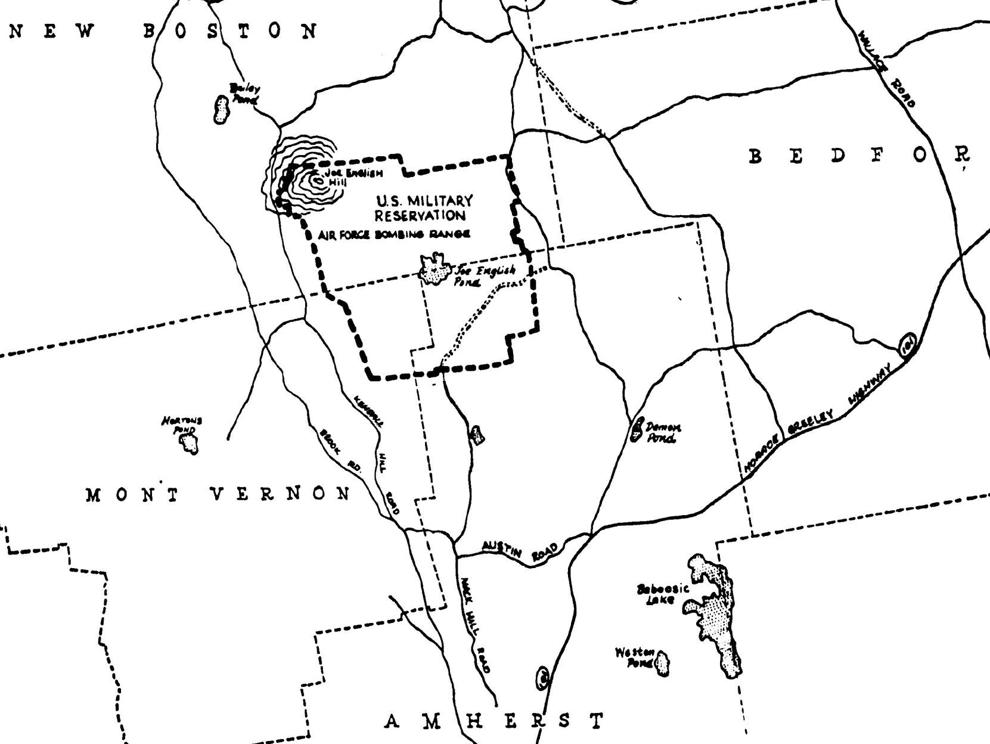08/06/2021 Stati Uniti, New Hampshire, Hillsborough
“If you ever come across anything suspicious like this item, please do not pick it up, contact your local law enforcement agency for assistance”
Beginning in World War II and into the mid-1950s, people living near the New Boston Bombing Range in south central New Hampshire were accustomed to the sight and sound of bombers and fighter planes buzzing overhead and the frequent “booms” of exploding ordnance. In speaking of her experiences, a local farmer who lived nearby, Evelyn Barss, was quoted in the Boston Globe in 1992 as stating, “…in the summertime when the planes were out there working there was no pleasure in conversation or in listening to the radio.” Centered in the town of New Boston and covering over 2,800 acres, this military reservation was associated with Grenier Field (beginning in late 1947 Grenier Air Force Base) in Manchester. The command at Grenier was careful to communicate as needed with the media regarding activities at the range. The public was provided with basic information about aircraft crashes — which fortunately were not frequent, but were too often tragic. Much of the news regarding the facility, however, was less dramatic and served general public relations purposes. For example, in late August, 1947, Col. Edwin L. Tucker, commanding officer of the 82nd Fighter Wing at Grenier, spoke to the press in response to complaints he had received from anxious civilians. An article in the Nashua Telegraph on Aug. 29, 1947 stated, “Grenier Field officials today assured citizens of the New Boston area that no danger exists from the night bombing experiments being conducted at the Grenier Field practice range there. The first series of tests has been completed; however, another series will be started within the next few weeks.” The article explained that scientists from Boston University and from Wright Field in Dayton, Ohio. were conducting experiments on night aerial photography techniques: “The flash bombs, released from the planes with a 12 second fuse, explode approximately 3,000 feet above the earth with a flash and loud report … Synchonized with a camera in the plane, the bombs illuminate the area with a one-million candlepower light for a brief interval during which the photograph is taken.” Local residents came out of their homes to view the spectacle. A few days later, a Grenier spokesperson contacted the local press again, this time to alert the public that there would be unusually heavy use of the bombing range for an unspecified length of time. The night bombing activity was completed, but now there would be daily bombing and machine gun practice during daylight hours. According to an item in the Nashua Telegraph on Sept. 4, “Only small practice bombs are used in the training, however, anyone wandering onto the military reservation will be in definite danger during those hours, especially from machine gun fire … Grenier’s P-51 Mustang squadrons will alternate with Navy squadrons from Quonset Point (Rhode Island) and Charlestown (Massachusetts) in utilizing the range so that it will be in operation at all times … Navy officers here to maintain radio communication with their planes … stated today that six types of naval aircraft will participate in the flights: F4U Corsairs, F8F Bearcats, F6F Hellcat photo planes, TBM Avengers, SB2 Helldivers and AD-1s (Skyraiders).” An alarming incident related to the bombing range took place on Friday, Aug. 31, 1951. Fortunately, the worst consequences were avoided. Mrs. Earl E. Setzer was alone in her small cottage in Amherst when a practice bomb from an Air Force plane crashed through her roof, traveled through a mattress and bedframe in her attic, and then went straight down through the ceiling and floor, and buried itself in the ground beneath the house where it began smoking, but did not explode. The 25-pound bomb had missed Mrs. Setzer by just a few feet. As the Nashua Telegraph reported, “When she saw smoke after it pierced through the floor, she called the fire department. Officials from the Grenier Air Force base in Manchester said the aircraft was in route to the practice bombing range at New Boston when the small, sand-filled practice bomb became loose and fell from the plane. … Splinters of wood were strewn about the house. The bomb was filled mostly with sand and a small charge of powder. Repairs to the home were immediately made by the installation office of the Grenier base …”
Next Week: Transitioning the New Boston Bombing Range into the space age.
Aurore Eaton is a historian and writer in Manchester, contact her at auroreeaton@aol.com or at www.facebook.com/AuroreEatonWriter
Foto-Fonte: unionleader.com
If you find anything that appears to be an explosive device, do not touch it, leave it where it is and call the police. We will contact the appropriate agencies to properly dispose of the item.





